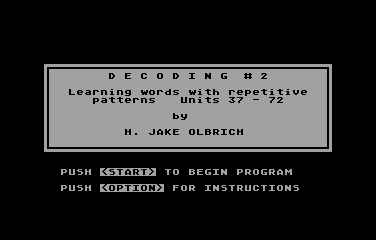Decoding
Decoding (C) 198? H. Jake Olbrich
- Learning English
- 3 Single density DOS disks
DECODING
Another program that we have had great success with is Decoding. It currently requires 3 SSSD disks to access the data although the program itself is quite small. This program is based on the book, HELPING CHILDREN OVERCOME LEARNING DIFFICULTIES by Jerome Rosner published by Walker Publishing Company. Our program is from the paperback edition pages 159-217. It features 108 phonic sounds in 4 levels. We have added for the Atari version a fifth level which simply separates the syllables of the highest level, as some children were having great difficulty and yet they insisted on being able to accomplish it. A further feature we added is a mini-dictionary to give the meaning of every word as some are quite unusual. We also made a number of corrections and a few deletions for our midwest dialect. It also is large print and the only input is to obtain a different level, dictionary or a new unit. It should be used with another person perhaps an older student, or parent. It is primarily an electronic blackboard with a dictionary. It certainly does help the children and they love to be able to learn to read. This book HELPING CHILDREN OVERCOME LEARNING DIFFICULTIES is also distributed by Educators Publishing Service. The huge value of this program is the large amount of Data that is available with the touch of a key. An ideal classroom setting would be exactly as Dr. David Thornburg Associate Editor of Compute Magazine suggests in his book The Empowered Teacher, published by Starsong Publications and in his article Computers and Society, page 70, September 1987, Compute Magazine. It is an ideal learning tool for those students with difficulty remembering the long, short, and sometimes schwa sound of the vowels and when and where to use them. This programs removes the confusion because each sound is used in groups and levels. Indeed the learning process starts with this program by anticipation. The program starts by typing in a sound. Immediately, before the first word appears the children are already guessing what the first few words will be. Soon they guess right and now the learning process is fun and fast. This program is practice and association. The sound to be practiced is always the same in every word. So, there is always one part of every word that they know. Now, the student associates that which he knows with what he reads. A little correction and reinforcement at appropriate times, there is no scoring, no timing, no drill, just learning. Mothers of near non-readers have told us they can notice a remarkable improvement after just two or three, one hour sessions per week. And not just one mother and not just one child. Ask the children after you try it, and they will tell you it helps them learn to read. My compliments to Dr. Rosner. A number of children have had great success with this program.
How To Use:
The program boots with Basic. Each disk has 36 units.
Decoding I features the sounds:
AT, AP, AB, AND, IT, AG, IN, IG, IB, ICK, OD, OT, OM, EN, ELL, ED, ET, ECK, EST, AD, AS, AM, ACK, AN, IP, ID, IM, ILL, OP, OG, ONG, OB, ESS, ENT, EM, and EB.Decoding II features the sounds:
ACE, ACT, ADE, AGE, AKE, ALE, AME, ANE, ANG, ANK, APE, ASH, AST, ATE, AVE, AY, EAM, EAT, IDE, IFF, IND, ING, INK, ISH, ITE, OKE, OLD, ONE, UB, UCK, UD, UG, UM, UN, UP, and UT.Decoding III features the sounds:
ABLE, AI, ALK, ALL, AR, ARE, AW, BULL, COW, DULL, EE, ER, EV, EW, ICE, IGHT, IR, IRE, OA, OCK, OI, OLL, ON, OO, OOK, OR, ORE, OU, OVE, SOW, TION, UE, UFF, URE, US, and USH.
The “SELECT” key has two functions. If, there are more words in a level than can fit on the screen, then the prompt will show:PUSH SELECT FOR EXTRA WORDS
If all of the words for that level have been displayed an asterisk will be visible on the screen and the prompt for the SELECT key will read:
PUSH SELECT FOR NEW UNIT
By typing in a different sound at the prompt “What Decoding Unit”, you can go to a different unit. In practice we usually only use two different units per child per day. It is not necessary for the child to complete a unit through any level before going on to a new unit, and it is advisable that they complete units at any level rather than go through level 3 before starting a new unit.
Option gets you to the dictionary. Some words are very unusual. They are included for their practice value. However, their meaning if not known can impair the learning process. For this reason I included a dictionary. Even then I was not able to come up with a definition in all cases. If the child requests or has reason to know the meaning of a word then press OPTION. And type the word. The definition appears at the bottom of the screen. If another definition is wanted, again press option and type the word. If you are in a level 3 and the meaning of a word from another level is wanted, you do not need to first go to that level, if you are able to spell the word correctly.
Even if the prompts have disappeared from the screen, simply typing a 0, 1, 2, 3, or 4 will get you to that level.
Support available for this and other programs from:H. Jake Olbrich
3693 Renfro Road
Cherry Valley, IL 61016
815-332-5303
Bootable disks (ATR / 7-Zip): Decoding










People’s Thoughts